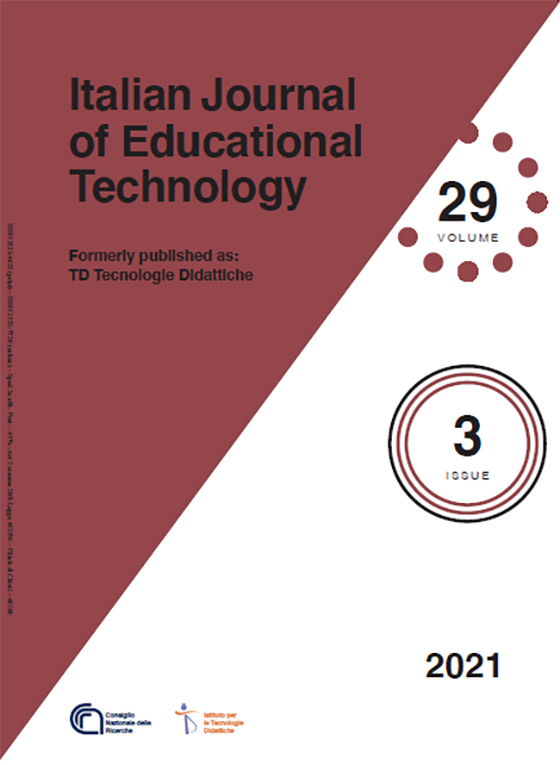NARRARE IL MUSEO PER PROMUOVERE L’EMPATIA E IL PENSIERO CRITICO NEI MEDICI IN RUOLO E IN FORMAZIONE ATTRAVERSO ATTIVITÀ ONLINE. UN’ESPERIENZA PILOTA DI RICERCA
Contenuto principale dell'articolo
Abstract
L'esperienza di ricerca "Narrare il museo per promuovere l’empatia e il pensiero critico in studenti di medicina e dottori", realizzata nell'ambito del progetto "Inclusive Memory", co-finanziato dall’Università Roma Tre, mira a promuovere l'empatia e la capacità di pensiero critico nei medici, anche in formazione, attraverso attività di educazione al patrimonio. Le caratteristiche innovative dell'esperienza di ricerca risiedono nell'utilizzo di attività online, che combinano diverse metodologie di apprendimento: Visual Thinking Strategies, Reflective Questioning, Storytelling e Object-based learning. Il contributo presenta i risultati dell'attività pilota svolta dal gruppo di ricerca del Centro di Didattica Museale, con sede presso il Dipartimento di Scienze della Formazione dell’Università Roma Tre, in collaborazione con Sapienza Università di Roma. Vengono inoltre descritte le attività didattiche, gli strumenti di apprendimento e di valutazione utilizzati durante tale esperienza, che ha coinvolto 35 partecipanti. I risultati della sperimentazione descritta evidenziano un miglioramento statisticamente significativo per quanto riguarda l’indicatore di pensiero critico “uso della lingua” e un miglioramento della dimensione empatica della sensibilità al contesto; i partecipanti dichiarano che i loro livelli di comunicazione e pensiero critico migliorano alla fine delle attività e che gli esercizi progettati stimolano la riflessione, l'osservazione e l'interpretazione.
Dettagli dell'articolo
Gli autori che pubblicano su questa rivista accettano le seguenti condizioni:
- Gli autori mantengono i diritti sulla loro opera e cedono alla rivista il diritto di prima pubblicazione dell'opera, contemporaneamente licenziata sotto una Licenza Creative Commons CC BY 4.0 Attribution 4.0 International License.
- Gli autori possono aderire ad altri accordi di licenza non esclusiva per la distribuzione della versione dell'opera pubblicata (es. depositarla in un archivio istituzionale o pubblicarla in una monografia), a patto di indicare che la prima pubblicazione è avvenuta su questa rivista.
- Gli autori possono diffondere la loro opera online (es. in repository istituzionali o nel loro sito web) prima e durante il processo di submission, poiché può portare a scambi produttivi e aumentare le citazioni dell'opera pubblicata (Vedi The effect of Open Access).
Riferimenti bibliografici
Baudelaire, C. (1857). Les Fleurs Du Mal. Paris, FR: Poulet-Malassis & De Broise.
Bentwich, M. E., & Gilbey, P. (2017). More than visual literacy: art and the enhancement of tolerance for ambiguity and empathy. BMC Medical Education, 17(200). doi: 10.1186/s12909-017-1088-8
Bourgault, P., Lavoie, S., Paul-Savoie, E., Grégoire, M., Michaud, C., Gosselin, E., & Johnston, C. (2015). Relationship Between Empathy and Well-Being Among Emergency Nurses. Journal of Emergency Nursing, 41(4), 323-328, doi:10.1016/j.jen.2014.10.001
Brazeau, C. M., Schroeder, R., Rovi, S., & Boyd, L. (2010). Relationships between medical student burnout, empathy, and professionalism climate. Academic Medicine, 85(10), 33-36.
Bufalino, G. (1981). Diceria dell’untore. Palermo, IT: Sellerio.
Carré, A., Stefaniak, N., D'ambrosio, F., Bensalah, L., & Besche-Richard, C. (2013). The basic empathy scale in adults (BES-A): Factor structure of a revised form. Psychological Assessment, 25(3), 679-691. doi:10.1037/a0032297
Catterall, J. S., & Deasy, R. (Eds.). (2002). Critical links: Learning in the arts and student academic and social development. Washington, DC, US: National Endowment for the Arts.
Chatterjee, H. J., & Hannan, L. (2016). Engaging the senses: object-based learning in higher education. New York, NY, US: Routledge.
Cole, T. R., Carlin, N. S., & Carson, R. A. (2014). Medical humanities: an introduction. Cambridge University Press.
Dewey, J. (1910). How we think. Boston, MA, US: DC Heath and Company.
Dominguez, C. (Ed.). (2018). A European review on critical thinking educational practices in higher education institutions. Vila Real, SP: UTAD.
Duhs, R. (2019). “Hands on” learning from museums and collections in higher education. In A. Poce (Ed.), Studi Avanzati di Educazione Museale. Lezioni. Advanced Studies in Museum Education. Lectures. Napoli, IT: ESI.
Gibbs, G. (1988). Learning by doing: a guide to teaching and learning methods. Oxford, UK: Further Education Unit.
Grever, M., De Bruijn, P., & Van Boxtel, C. (2012). Negotiating historical distance: Or, how to deal with the past as a foreign country in heritage education. Paedagogica Historica, 48,873–887.
Halpern, J. (2003). What is clinical empathy? Journal of General Internal Medicine, 18(8), 670-674.
Hakkarainen, K. A. I. (2003). Emergence of progressive-inquiry culture in computer-supported collaborative learning. Learning Environments Research, 6(2), 199-220.
Housen, A.C. (2001). Æsthetic thought, critical thinking and transfer. Arts and Learning Research, 18(1), 99-132.
Hubard, O. (2011). Rethinking Critical Thinking and Its Role in Art Museum Education. The Journal of Aesthetic Education, 45(3), 15-21.
Jacques, A., Stone, L., Tang, R., Hudson, W. A, & Khandelwal, S. (2012). Art of Analysis: A cooperative program between a museum and medicine. Journal for Learning through the Arts, 8(1), 1-10.
Kesebir, P., Gasiorowska, A., Goldman, R., Hirshberg, M. J., & Davidson, R. J. (2019). Emotional Style Questionnaire: A multidimensional measure of healthy emotionality. Psychological Assessment, 31(10), 1234–1246. doi:10.1037/pas0000745
Kim, B. (2001). Social constructivism. Emerging Perspectives on Learning, Teaching, and Technology, 1(1), 16.
Landau, R. L. (1993). And the least of these is empathy. In H.M. Spiro, E. Peschel, M. G. McCrea Curnen, & D. St. James (Eds.), Empathy and the practice of medicine: Beyond pills and the scalpel (pp. 103–109). New Haven, NY, US: Yale University Press.
Lieberman, I. D., & Parker, M. E. (2019). Turning theory into practice: A case study in the arts. Journal for Learning through the Arts, 15(1). doi:10.21977/D915142042
Mukunda, N., Moghbeli, N., Rizzo, A., Niepold, S., Bassett, B., & DeLisser, H. M. (2019). Visual art instruction in medical education: a narrative review. Medical Education Online, 24(1), 1558657. doi:10.1080/10872981.2018.1558657
National Council for Curriculum and Assessment (2017). Guidelines for Wellbeing in Junior Cycle. Retrieved from https://ncca.ie/media/2487/wellbeingguidelines_forjunior_cycle.pdf
Oswald, S., Herman, T., & Jacquin, J. (2018). Argumentation and Language – Linguistic, Cognitive and Discursive Explorations, Social Sciences. Cham, CH: Springer.
Pascoli, G. (1891). Myricae. Livorno, IT: Raffaello Giusti Editore.
Pedersen, E. M. (1995). Storytelling and the art of teaching. English Teaching Forum, 33(1), 2-5.
Poce, A. (2017). Verba sequentur. Pensiero e scrittura per uno sviluppo critico delle competenze nella scuola secondaria. Milano, IT: Franco Angeli.
Poce, A. (Ed.) (2020). Memoria, inclusione e fruizione del patrimonio culturale. Primi risultati del progetto inclusive memory dell’Università Roma Tre. Napoli, IT: ESI.
Poce, A., Agrusti, F., & Re, M.R. (2015). Sviluppo di uno strumento di valutazione delle risorse aperte (OERs). Cadmo, Giornale Italiano di Pedagogia Sperimentale, 2(23), 81-98. doi: 10.3280/CAD2015-002008
Poce, A. & Amenduni, F. (2019). Creative writing and critical thinking enhancement at higher education. In Proceedings of the HEAD’19 5th International Conference on Higher Education Advances, Valencia, Spain,26–58 June 2019 (pp. 459–467). doi: 10.4995/HEAd19.2019.9221
Poce, A., Amenduni, F., Re, M.R., De Medio, C., & Norgini, A. (2020a). Correlations among natural language processing indicators and critical thinking sub-dimensions in HiEd students. Form@re - Open Journal Per La Formazione in Rete, 20(3), 43-67. doi:10.13128/form-9902
Poce, A., Caccamo, A., Amenduni, F., Re, M.R., De Medio, C., Valente, M. (2020b). A Virtual Reality Etruscan Museum Exhibition–Preliminary Results of the Participants’ Experience. In EDEN Conference Proceedings (Vol. 1, pp. 40-49). Retrieved from https://www.eden-online.org/proc-2485/index.php/PROC/article/download/1757/1465
Ratka A. (2018). Empathy and the development of affective skills. American Journal of Pharmaceutical Education, 82(10), 1140-1143. doi: 10.5688/ajpe7192
Schoonover, N. R. (2021). Exploring visual literacy skills and dispositions through a museum-sponsored online professional development for K-12 teachers. Journal of Visual Literacy, 1-19.
Terrassa, J., Hubard, O., Holtrop, E., & Higgins-Linder, M., (2016). Impact of art museum programs on students: Literature review. Alexandria, VA, US: National Art Education Association.
Thorbun, M. (2017). Wellbeing, education and contemporary schooling. London, UK: Routledge.
Tishman, S., MacGillivray, D., & Palmer, P. (1999). Investigating the educational impact and potential of the Museum of Modern Art’s visual thinking curriculum. Cambridge, MA, US: Harvard Project Zero.
Ungaretti, G. (1969). Il dolore. Milano, IT: Mondadori.
Ungaretti, G. (1916). Il porto sepolto. Udine, IT: Stabilimento Tipografico Friulano.
Ware, C. (2008). Visual Thinking for Design. Amsterdam, NL: Elsevier.
Winefield, H. R., & Chur-Hansen, A. (2000). Evaluating the outcome of communication skill teaching for entry-level medical students: Does knowledge of empathy increase? Medical Education, 34(1), 90–94.
Zannini, L. (2008). Medical humanities e medicina narrativa: nuove prospettive nella formazione dei professionisti della cura. Milano, IT: Cortina.
Zayapragassarazan, Z., & Chacko, T. V. (2019). A gap analysis of critical thinking skills and attitude toward critical thinking among interns. International Journal of Health & Allied Sciences, 8(3), 193-196. doi: 10.4103/ijhas.IJHAS_22_19
Zazulak, J., Sanaee, M., Frolic, A., Knibb, N., Tesluk, E., Hughes, E., & Grierson, L. E. (2017). The art of medicine: arts-based training in observation and mindfulness for fostering the empathic response in medical residents. Medical Humanities, 43(3), 192-198. doi: 10.1136/medhum-2016-011180

